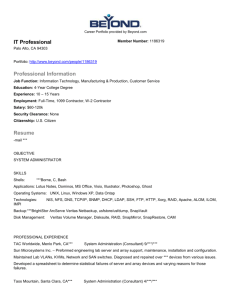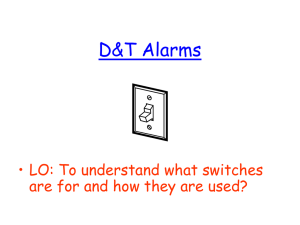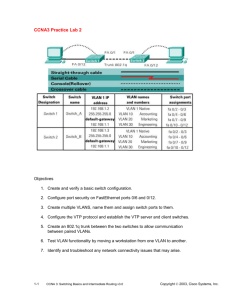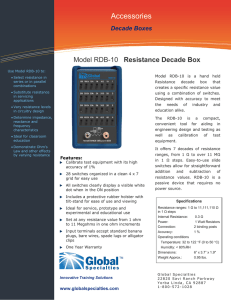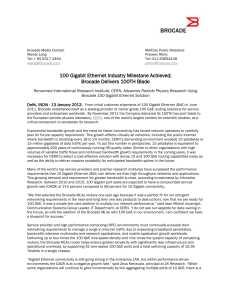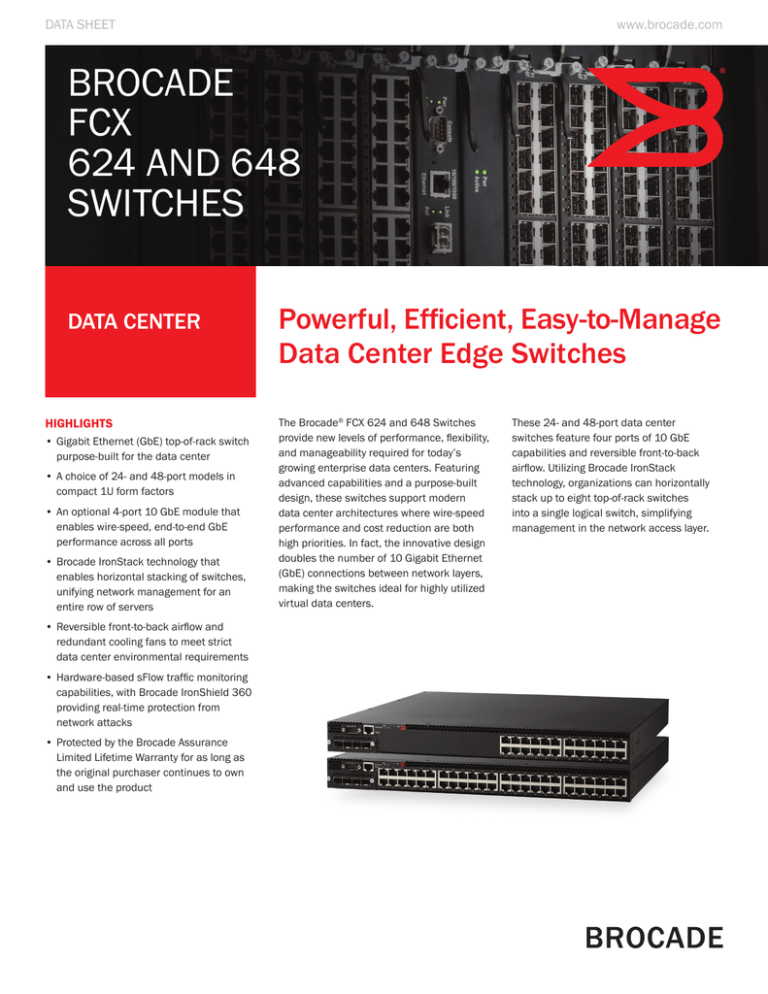
DATA SHEET
www.brocade.com
BROCADE
FCX
624 AND 648
SWITCHES
DATA CENTER
HIGHLIGHTS
•Gigabit Ethernet (GbE) top-of-rack switch
purpose-built for the data center
•A choice of 24- and 48-port models in
compact 1U form factors
•An optional 4-port 10 GbE module that
enables wire-speed, end-to-end GbE
performance across all ports
•Brocade IronStack technology that
enables horizontal stacking of switches,
unifying network management for an
entire row of servers
•Reversible front-to-back airflow and
redundant cooling fans to meet strict
data center environmental requirements
•Hardware-based sFlow traffic monitoring
capabilities, with Brocade IronShield 360
providing real-time protection from
network attacks
•Protected by the Brocade Assurance
Limited Lifetime Warranty for as long as
the original purchaser continues to own
and use the product
Powerful, Efficient, Easy-to-Manage
Data Center Edge Switches
The Brocade® FCX 624 and 648 Switches
provide new levels of performance, flexibility,
and manageability required for today’s
growing enterprise data centers. Featuring
advanced capabilities and a purpose-built
design, these switches support modern
data center architectures where wire-speed
performance and cost reduction are both
high priorities. In fact, the innovative design
doubles the number of 10 Gigabit Ethernet
(GbE) connections between network layers,
making the switches ideal for highly utilized
virtual data centers.
These 24- and 48-port data center
switches feature four ports of 10 GbE
capabilities and reversible front-to-back
airflow. Utilizing Brocade IronStack
technology, organizations can horizontally
stack up to eight top-of-rack switches
into a single logical switch, simplifying
management in the network access layer.
PURPOSE-BUILT FOR THE DATA CENTER
Modern enterprise data centers have strict
requirements in regard to form factor, port
density, power redundancy, and airflow for
servers, storage, and networking equipment.
To meet those requirements, the Brocade
FCX 624 and 648 switches feature a
purpose-built design to extend proven
Brocade technology into the data center.
Optional High-Density 10 GbE Module
Both switches accept an optional 10 GbE
module containing four SFP+ ports, enabling
high-bandwidth connectivity to the aggregation
or core layers, or creating a switch stack
horizontally across a row of servers. Utilizing
the SFP+ port form factor enables higher
density, more flexible cabling options, and
better energy efficiency. The ability to use
short-range and long-range optics, along
with copper Twinax cables, supports flexible
and cost-effective network architectures.
Industry-leading 4-port 10 GbE density in a
1U switch provides up to 40 Gbps of uplink
bandwidth to the aggregation or core layers
of the network (see Figure 1). Even with the
high-density 48-port model, this bandwidth
enables a near 1:1 subscription ratio throughout
the network. As a result, organizations can
deploy highly utilized networks to avoid
congestion during peak hours.
In a stack of Brocade FCX 624 or 648 switches,
up to eight 10 GbE links can be aggregated,
providing 80 Gbps of bandwidth between
the horizontal stack and the aggregation
or core layers.
Organizations can also use a 4-port GbE
SFP module for optical 1 GbE uplink
connections. In the future, as bandwidth
demands increase, organizations can
replace this module with the 4-port 10 GbE
module. This modular design increases
investment protection by supporting 10 GbE
deployment when the time is right.
Flexible Power and Cooling Options
Brocade FCX switches for the data center
optionally contain dual hot-swappable,
load-sharing, redundant power supplies
(see Figure 2). The modular design also has
a removable fan assembly containing four
redundant blowers. These features provide
another level of availability for data center
top-of-rack switches.
The Brocade FCX 624 and 648 are the first
Brocade data center Ethernet switches with
reversible front-to-back airflow options. This
design improves mounting flexibility in a
server rack, while adhering to the cooling
guidelines of the data center. Organizations
can specify airflow direction at the time of
order and can reverse the direction after
deployment by swapping the power supplies
and the fan assembly.
Additional design features include intake
and exhaust temperature sensors and fan
spin detection to streamline identification
of abnormal or failed operating conditions,
helping to minimize mean time to repair.
Compact Form Factor
Brocade FCX 624 and 648 switches provide
up to 48 GbE ports and four 10 GbE ports in
a compact 1U design. The shallow 17.2-inch
depth of the switch enables deployment in
next-generation high-density server designs
while providing ample room for optimal
cable management.
Core
Routers
40 Gbps
Uplinks
Server
Rows
Figure 1.
The optional 4-port 10 GbE module enables end-to-end, near-nonoversubscribed GbE performance throughout the data center network.
Aggregation
Switches
Figure 2.
Brocade FCX 624 and 648 data center switches feature reversible front-to-back airflow,
internal redundant power supplies, and a swappable fan assembly.
INCREASED SCALABILITY AND
SIMPLIFIED MANAGEMENT
Brocade FCX 624 and 648 switches provide
innovative ways to reduce management at the
edge of the data center network by unifying
management and simplifying scalability.
Simplified, High-Performance Stacking
The optional 10 GbE ports can unify a
group of top-of-rack switches, providing a
high-speed connection for server-to-server
communication while significantly reducing
network management. Leveraging Brocade
IronStack technology, organizations can
horizontally stack up to eight Brocade FCX 624
or 648 switches into a single logical switch.
This logically stacked switch has only a
single IP address to manage. When new
members join the stack, they automatically
inherit the stack’s configuration file, enabling
true plug-and-play network expansion.
Organizations can obtain console access to
the stack through any of the stack
members, eliminating the need to know
which member is the primary controller.
Within the stack, there is 40 Gbps of bandwidth
between stack members, providing efficient,
high-speed server-to-server connectivity
(see Figure 3). With four optional ports of
10 GbE capabilities, organizations can use
two ports for connecting to the stack and
two ports for high-speed connectivity to the
aggregation or core layers—providing
maximum flexibility in a compact data
center access switch.
HORIZONTAL STACKING
Stacking of Ethernet switches is most
commonly found in wiring closets of
enterprise campus networks. Stacking
functionality enables small-form-factor
switches to be linked using short copper
cables—and then the stack of switches
appears and behaves as a single
logical switch to simplify management.
When a new switch joins the stack, it
automatically inherits the configuration
of the stack without manual setup.
Stacking switches at the edge of data
center networks provides the same value
as it does in campus networks. The main
difference is that the switches are not
physically stacked on top of each other.
Instead, longer cables logically unify the
switches at the top of each server rack.
For example, a row of top-of-rack switches
can appear as a single logical switch,
significantly reducing management
overhead of the data center access layer.
Organizations can trunk 10 GbE ports from
different members of the stack to optimize
performance and availability. To maximize the
flexibility of which switches in the data center
are members of a stack, organizations can
use copper Twinax cables for short-distance
connectivity and use fiber-optic cables to
connect switches over longer distances.
40 Gbps
10 GbE for
Stacking
1 GbE
Figure 3.
Brocade FCX 624 and 648 switches at the top of server racks can be stacked into a
single logical switch and then connected to the aggregation layer through the optional
4-port 10 GbE module.
REDUCED POWER CONSUMPTION
In today’s rapidly growing business
environments, organizations need to
minimize power consumption throughout
the entire IT infrastructure. Brocade FCX
624 and 648 switches are designed to
reduce power usage, adhering to “green”
initiatives in modern data centers.
snooping and Passive Multicast Router
Insertion (PMRI) can be combined, ensuring
multicast distribution in Layer 2 networks.
The switches use the PIM Snooping feature
to acquire multicast routes, enabling them
to intelligently switch multicast traffic rather
than blindly broadcasting multicast traffic in
the Layer 2 domain.
Operating at power levels as low as
1.27 watts/Gbps, these switches consume
minimal power for the performance and
functionality they provide.
Advanced (-ADV) models include BGP
routing capabilities, enabling remote offices
to connect the Brocade FCX 624 and 648
switches to service provider networks.
ADVANCED CAPABILITIES
Metro Features Connecting
Buildings and Campuses
To meet a wide range of requirements,
Brocade FCX 624 and 648 switches
provide full Layer 3 capabilities, along with
metro features for connecting buildings
and campuses.
Full Layer 3 Capabilities
Layer 3 functionality enhances the
capability of the switches as a flexible data
center solution. Organizations can use Layer
3 features such as IPv4 Open Shortest
Path First (OSPF) and Routing Information
Protocol (RIP) routing, policy-based routing,
Virtual Router Redundancy Protocol (VRRP),
and Dynamic Host Configuration Protocol
(DHCP) Relay. In addition, organizations can
remove complexity from end-to-end Layer
3 networks by utilizing Layer 3 capabilities
built into every Brocade FCX switch.
For example, data-rich applications such as
video distribution require scalable multicast
services from end to end. The switches
provide Internet Group Management
Protocol (IGMP) and Protocol-Independent
Multicast (PIM) snooping to improve
bandwidth utilization in Layer 2 networks by
restricting multicast flows to only the switch
ports that have multicast receivers.
In Layer 3 networks, support for IGMP
(v1, v2, and v3), IGMP Proxy, PIM-SM,
PIM-SSM, and PIM-DM multicast routing
optimizes network utilization and traffic
routing for multicast applications. PIM
Because Brocade FCX 624 and 648 switches
contain Metropolitan Area Network (MAN)
features, organizations can use them to
connect a distributed enterprise. In this type
of environment, the switches provide rich
services using MRP (v1 and v2) for building
resilient ring-based topologies, Virtual LAN
(VLAN) stacking, and advanced multicast
capabilities—including IGMP v1/v2/v3 and
Multicast Listener Discovery (MLD) v1/v2
snooping for controlling multicast traffic for
high-bandwidth content delivery.
COMPREHENSIVE
ENTERPRISE-CLASS SECURITY
Brocade FCX 624 and 648 switches utilize
the Brocade IronWare® operating system,
providing a rich security suite for a wide
range of Layer 2 and Layer 3 services.
Threat Detection and Mitigation
The switches utilize embedded hardwarebased sFlow traffic sampling to extend Brocade
IronShield® 360 security to the network edge.
This unique and powerful closed-loop threat
mitigation solution uses best-in-class intrusion
detection systems to inspect traffic samples
for possible network attacks.
In response to a detected attack, Brocade
IronView® Network Manager (INM) can
automatically apply a security policy to the
compromised port, stopping network attacks
in real time without administrator intervention.
Advanced Multicast Features
The switches support a rich set of Layer 2
multicast snooping features that enable
advanced multicast services delivery. IGMP
snooping for IGMP version 1, 2, and 3 is
supported. Support for IGMP v3 sourcebased multicast snooping improves bandwidth
utilization and security for multicast services.
To enable multicast service delivery in IPv6
networks, the switches support MLD v1/v2
snooping, the multicast protocols used in
IPv6 environments.
Network Resiliency through
Fault Detection
Software features such as Virtual Switch
Redundancy Protocol (VSRP), Brocade
Metro-Ring Protocol (MRP) v1 and v2, Rapid
Spanning Tree Protocol (RSTP), protected
link groups, 802.3ad Link Aggregation,
and trunk groups provide alternate paths
for traffic in the event of a link failure.
Sub-second fault detection utilizing Link
Fault Signaling (LFS) and Remote Fault
Notification (RFN) helps ensure fast fault
detection and recovery.
Enhanced spanning tree features such
as Root Guard and Bridge Protocol Data
Unit (BPDU) Guard prevent rogue hijacking
of a spanning tree root and maintain a
contention- and loop-free environment,
especially during dynamic network
deployments. In addition, the switches
support port loop detection on edge ports
that do not have spanning tree enabled.
This capability protects the network from
broadcast storms and other anomalies that
can result from Layer 1 or Layer 2 loopbacks
on Ethernet cables or endpoints.
Protected link groups minimize disruption
to the network by protecting critical links
from loss of data and power. In a protected
link group, one port in the group acts as
the primary or active link, and the other
ports act as secondary or standby links. The
active link carries the traffic and, if it goes
down, one of the standby links takes over.
UniDirectional Link Detection (UDLD)
monitors a link between two switches and
brings down the ports on both ends of the
link if the link fails at any point between the
two devices.
The switches also support stability features
such as port flap dampening, single-link
Link Aggregation Control Protocol (LACP),
and port loop detection.
SIMPLIFIED, SECURE MANAGEMENT
BASED ON OPEN STANDARDS
Brocade FCX 624 and 648 switches provide
simplified, standards-based management
capabilities that help organizations reduce
administrative time and effort while
securing their networks.
Simplified Deployment with
Auto-Configuration
The switches support auto-configuration,
simplifying deployment with a truly plug-andplay experience. Organizations can use this
feature to automate IP address and feature
configuration of the switches without
complex manual configuration. When the
switches power up, they automatically
receive an IP address from DHCP and
configuration information from an already
configured Trivial File Transport Protocol
(TFTP) server. At this time, the switches
can also automatically receive a software
update to be at the same code revision as
already installed switches.
Brocade IronView Network Manager
Brocade INM provides unified management
for Brocade FCX 624 and 648 switches
along with the rest of the Brocade
Ethernet network. It displays network- and
application-level traffic information in
graphical detail to greatly simplify network
operations, provisioning, troubleshooting,
and alarm reporting.
As a result, organizations can accurately
monitor overall networking operation, identify
hot spots, and quickly diagnose and
troubleshoot issues before they develop into
widespread network problems. In addition,
Brocade INM provides multilevel access
security on the console and a secure Webbased management interface that keeps
out unauthorized users while providing
simple and flexible administrative access.
Open Standards-Based Management
The switches include an industry-standard
Command Line Interface (CLI) and support
Secure Shell (SSHv2), Secure Copy (SCP),
and SNMP v3 to restrict and encrypt
management communications to the
system. In addition, support for Terminal
Access Controller Access Control System
(TACACS/TACACS+) and RADIUS authentication
helps ensure secure operator access.
Out-of-Band Management
The switches include an RJ-45 Ethernet
port dedicated to out-of-band management,
providing a remote path to manage the
switches, regardless of the status or
configuration of the data ports.
IDEAL FOR ETHERNET STORAGE TRAFFIC
Modern iSCSI Storage Area Network (SAN)
environments require a high-performance
network to reliably deliver block storage to
servers. Brocade FCX 624 and 648 switches
provide robust performance capabilities to
handle servers that are saturating GbE links
with storage traffic.
The combination of 10 GbE SFP+ ports and
the IronStack technology enables organizations
to expand their iSCSI storage environments
with no additional management. The
Brocade FCX switch stack can be connected
to a full 10 GbE switch for SAN expansion
with 10 Gigabit iSCSI storage. In addition,
internal redundant power supplies and
a swappable fan assembly provide the
high-availability features required in
shared storage environments.
BROCADE GLOBAL SERVICES
To help organizations get the most value
from their technology investments, Brocade
Global Services offers a variety of services
with comprehensive hardware and 24×7
software support, including software fixes
and new releases. Organizations can also
utilize Brocade Professional Services to
implement and validate the functionality
of Brocade products. Leveraging the
Brocade Network Monitoring Service (NMS),
organizations can maximize the availability
and performance of their critical application
environments while reducing infrastructure
cost and complexity.
WARRANTY
Brocade FCX switches are covered by
the Brocade Assurance™ Limited Lifetime
Warranty for as long as the original
purchaser continues to own and use the
product. The warranty covers the product
hardware, including internal power supplies
and internal fans, as well as software
defect repairs. To streamline the product
replacement process, qualified customers
can directly access the Brocade Knowledge
Portal to initiate advanced replacement on
registered products.
MAXIMIZING INVESTMENTS
To help optimize technology investments,
Brocade and its partners offer complete
solutions that include education, support,
and services. For more information,
contact a Brocade sales partner or visit
www.brocade.com.
BROCADE FCX SERIES FEATURE COMPARISON
Data Center
Enterprise Campus Network
FCX 624
FCX 648
FCX 624S
FCX 648S
FCX 624S-F
FCX 624S-HPOE
FCX 648S-HPOE
Switching bandwidth
(data rate, full duplex)
128 Gbps
176 Gbps
152 Gbps
200 Gbps
152 Gbps
152 Gbps
200 Gbps
Forwarding bandwidth
(data rate, full duplex)
96 Mpps
132 Mpps
114 Mpps
150 Mpps
114 Mpps
114 Mpps
150 Mpps
Stacking bandwidth
(data rate, full duplex)
40 Gbps
40 Gbps
64 Gbps
64 Gbps
64 Gbps
64 Gbps
64 Gbps
10/100/1000 Mbps
RJ-45 ports
24
48
24
48
n/a
24
48
100/1000 Mbps
SFP ports
n/a
n/a
n/a
n/a
20
n/a
n/a
1000 Mbps combo
ports
4 (optional)
4 (optional)
4
4
4
4
4
10 Gigabit Ethernet
XFP/CX4 ports
n/a
n/a
2 (optional)
2 (optional)
2 (optional)
2 (optional)
2 (optional)
10 Gigabit Ethernet
SFP+ ports
4 (optional)
4 (optional)
n/a
n/a
n/a
n/a
n/a
16 Gbps CX4
stacking ports
n/a
n/a
2
2
2
2
2
Maximum PoE Class
3 ports
n/a
n/a
n/a
n/a
n/a
24
48
Maximum PoE+ ports
n/a
n/a
n/a
n/a
n/a
24
26
Power supplies
2 removable
(second optional)
2 removable
(second optional)
2 removable
(second optional)
2 removable
(second optional)
2 removable
(second optional)
2 removable
(second optional)
2 removable
(second optional)
1000 Mbps combo
module
FCX-4G
FCX-4G
n/a
n/a
n/a
n/a
n/a
10 Gigabit Ethernet
module
FCX-4XG
FCX-4XG
FCX-2XG
FCX-2XG
FCX-2XG
FCX-2XG
FCX-2XG
Second power supply
RPS13/
RPS13-I
RPS13/
RPS13-I
RPS13
RPS13
RPS13
RPS14
RPS14
Replacement fan unit
FCX-FAN-E/
FCX-FAN-I
FCX-FAN-E/
FCX-FAN-I
FCX-S-FAN
FCX-S-FAN
FCX-S--FAN
FCX-S-POE-FAN
FCX-S-POE-FAN
Optional FRUs
BROCADE FCX 624 AND 648 SWITCH SPECIFICATIONS
System architecture
Connector options
10/100/1000 ports: RJ-45 (fixed)
1 Gbps SFP combo ports: SX, LX, LHA, LHB,
1000Base-BX, CWDM
10 Gbps SFP+ ports: Direct-Attached Copper
(Twinax), SR, LR
Out-of-band Ethernet management: RJ-45 (fixed)
Console management: DB9
Maximum MAC
addresses
32,000
Maximum VLANs
4096
Maximum STP
(spanning trees)
255
Maximum routes
(in hardware)
16,000
Trunking
Maximum ports per trunk: 8
Maximum trunk groups: 32
Maximum Jumbo
Frame size
9000 bytes
IEEE standards
compliance
• 802.1AB LLDP/LLDP-MED
• 802.1D-2004 MAC Bridging
• 802.1p Mapping to Priority Queue
• 802.1s Multiple Spanning Tree
• 802.1w Rapid Spanning Tree
• 802.1x Port-based Network Access Control
• 802.3 10 Base-T
• 802.3ab 1000 Base-T
• 802.3ad Link Aggregation (dynamic and static)
• 802.3ae 10 Gigabit Ethernet
• 802.3u 100 Base-TX
• 802.3x Flow Control
• 802.3z 1000Base-SX/LX
• 802.3 MAU MIB (RFC 2239)
Layer 2 switching
• 802.1s Multiple Spanning Tree
• 802.1x Authentication
• Auto MDI/MDIX
• BPDU Guard, Root Guard
• Dual-Mode VLANs
• Dynamic VLAN Assignment
• Dynamic Voice VLAN Assignment
• Fast Port Span
• Flexible Static Multicast MAC Address
Configuration
• GARP VLAN Registration Protocol
• IGMP Snooping (v1/v2/v3)
• Link Fault Signaling (LFS)
• MAC Address Locking
• MAC-Layer Filtering
• MAC Learning Disable; Port Security
• MLD Snooping (v1/v2)
• Multi-device Authentication
• Per VLAN Spanning Tree (PVST/PVST+/PVRST
• PIM–SM Snooping
• Policy-controlled MAC-based VLANs
• Port-based Access Control Lists
• Port-based, ACL-based, MAC Filter-based,
and VLAN-based Mirroring
• Port Loop Detection
• Port Speed Downshift and Selective
Auto-negotiation
• Private VLAN
• Private VLANs and Uplink Switch
• Protected Link Groups
• Protocol VLAN (802.1v), Subnet VLAN
• Remote Fault Notification (RFN)
• Single-instance Spanning Tree
• Single-link LACP
• Trunk Groups
• Trunk Threshold
• UniDirectional Link Detection (UDLD)
Layer 3 routing
• ECMP
• Host routes
• IPv4 static routes
• Layer 3/Layer 4 ACLs RIP v1/v2 announce
• OSPF v2
• PIM-SM, PIM-SSM, PIM-DM
• RIP v1/v2
• Routed interfaces
• Route-only support
• Routing between directly connected subnets
• Virtual interfaces
• Virtual Route Redundancy Protocol (VRRP)
Advanced functionality
(included with –ADV
models)
• BGP
Metro features
• Metro-Ring Protocol (v1, v2)
• Virtual Switch Redundancy Protocol (VSRP)
• VLAN Stacking (Q-in-Q)
• VRRP
Quality of service
• ACL Mapping and Marking of ToS/DSCP
• ACL Mapping to Priority Queue
• ACL Mapping to ToS/DSCP
• Adaptive Rate Limiting
• Classifying and limiting flows based on TCP flags
• DHCP Option 82
• DHCP Relay
• DiffServ Support
• Honoring DSCP and 802.1p
• MAC Address Mapping to Priority Queue
• QoS Queue Management using Weighted
Round Robin (WRR), Strict Priority (SP), and a
combination of WRR and SP
Traffic management
• ACL-based inbound rate limiting and traffic policies
• Broadcast, multicast, and unknown unicast
rate limiting
• Inbound rate limiting per port
• Outbound rate limiting per port and per queue
Management
Management and
control
• Auto-configuration
• Configuration logging
• Digital optical monitoring
• Display log messages on multiple terminals
• Embedded Web management
• Foundry Discovery Protocol (FDP)
• Industry-standard Command Line Interface (CLI)
• Integration with HP OpenView for Sun Solaris,
HP-UX, IBM AIX, and Windows
• IronView Network Manager (INM)
Version 3.3 or later
• MIB Support for MRP, Port Security, MAC
Authentication, and MAC-based VLANs
• Out-of-band Ethernet management
• RFC 783 TFTP
• RFC 854 TELNET Client and Server
• RFC 1157 SNMPv1/v2c
• RFC 1213 MIB-II
• RFC 1493 Bridge MIB
• RFC 1516 Repeater MIB
• RFC 1573 SNMP MIB II
• RFC 1643 Ethernet Interface MIB
• RFC 1643 Ethernet MIB
• RFC 1724 RIP v1/v2 MIB
• RFC 1757 RMON MIB
• RFC 2068 Embedded HTTP
• RFC 2131 DHCP Relay
• RFC 2570 SNMPv3 Intro to Framework
• RFC 2571 Architecture for Describing
SNMP Framework
• RFC 2572 SNMP Message Processing
and Dispatching
• RFC 2573 SNMPv3 Applications
• RFC 2574 SNMPv3 User-based Security Model
• RFC 2575 SNMP View-based Access Control
Model SNMP
• RFC 2818 Embedded HTTPS
• RFC 3176 sFlow
• SNTP Simple Network Time Protocol
• Support for multiple Syslog servers
Embedded security
• 802.1x accounting
• Bi-level Access Mode (Standard and EXEC Level)
• EAP pass-through support
• IEEE 802.1X username export in sFlow
• Protection against Denial of Service (DOS)
attacks
DATA SHEET
Secure management
www.brocade.com
Environmental
• Authentication, Authorization, and
Accounting (AAA)
• Advanced Encryption Standard (AES)
with SSHv2, SNMPv3
• RADIUS/TACACS/TACACS+
• Secure Copy (SCP)
• Secure Shell (SSHv2)
• Username/password
• Web authentication
Temperature
Storage temperature: –23° to 158°F (–25° to 70°C)
Size
Humidity
Relative humidity: 5% to 95%, non-condensing
Altitude
Storage altitude: 10,000 ft (3000 m) maximum
Acoustic
51 to 63 dB
Power
Power supplies
Front-to-back airflow (reversible); 1U,
19-inch EIA-compliant, power from non-port side
Up to two internal, redundant, field-replaceable,
load-sharing AC power supplies
Power inlet
C13
Width: 44.0 cm (17.3 in)
Input voltage
Typical 100 to 240 VAC
Input line frequency
50 to 60 Hz
Mechanical
Enclosure
Operating temperature: 32° to 104°F (0° to 40°C)
Height: 4.4 cm (1.7 in)
Certification
Depth: 43.5 cm (17.2 in)
Electromagnetic
emissions
FCC Class A (Part 15); EN 55022/CISPR-22 Class A;
VCCI Class A
Environmental
regulatory compliance
RoHS-compliant (6 of 6); WEEE-compliant
BROCADE FCX 624 AND 648 SWITCH POWER AND THERMAL SPECIFICATIONS
Max Current
at 100 VAC
(Amps)
Max Current
at 200 VAC
(Amps)
Max System
Power Draw
(Watts)
Max Thermal
Output
(BTU/Hr)
Energy
Efficiency
(Watts/Gbps)2
FCX 6241
0.9
0.6
92.0
312.8
1.4
FCX 6481
1.2
0.7
112.0
421.6
1.3
1
With 4-port 10 GbE module installed and one power supply
2
Calculated using switch data rate
Corporate Headquarters
San Jose, CA USA
T: +1-408-333-8000
info@brocade.com
European Headquarters
Geneva, Switzerland
T: +41-22-799-56-40
emea-info@brocade.com
Asia Pacific Headquarters
Singapore
T: +65-6538-4700
apac-info@brocade.com
© 2010 Brocade Communications Systems, Inc. All Rights Reserved. 03/10 GA-DS-1453-00
Brocade, the B-wing symbol, BigIron, DCX, Fabric OS, FastIron, IronView, NetIron, SAN Health, ServerIron, and TurboIron
are registered trademarks, and Brocade Assurance, DCFM, Extraordinary Networks, and Brocade NET Health are
trademarks of Brocade Communications Systems, Inc., in the United States and/or in other countries. Other brands,
products, or service names mentioned are or may be trademarks or service marks of their respective owners.
Notice: This document is for informational purposes only and does not set forth any warranty, expressed or implied,
concerning any equipment, equipment feature, or service offered or to be offered by Brocade. Brocade reserves the
right to make changes to this document at any time, without notice, and assumes no responsibility for its use. This
informational document describes features that may not be currently available. Contact a Brocade sales office for
information on feature and product availability. Export of technical data contained in this document may require an
export license from the United States government.

